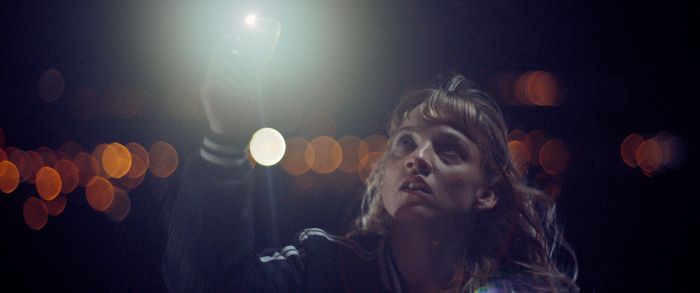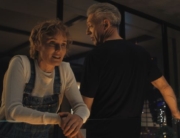Not every science fiction movie has to be a massive spectacle of visual effects and production design, but it should always find seductive ways to convey big ideas and visual sensations. A compelling, understated sci-fi storyline (like in Arrival) never feels underwhelming. That’s the main problem with Meanwhile on Earth, which has a premise with limitless possibilities that could hook the audience’s curiosity but ultimately settles for more pedestrian and tedious routes.
After an exceptional debut with the animated film I Lost My Body, which followed the journey of a severed hand, French director Jérémy Clapin takes on a bigger challenge with his first live-action feature. Meanwhile on Earth, as its title suggests, doesn’t leave our planet to explore space. Instead, it hints at the possibility of extraterrestrial contact. The opening shot presents a commemorative statue of an astronaut, silhouetted against a starry sky as if it’s floating down and might step right out of the screen. A young woman spray paints the monument, not as an act of vandalism, but rather as an expression of her anger and grief over losing her brother, the very figure it represents.
Franck (voiced by Sébastien Pouderoux) never returned from a space mission and has been officially presumed dead. Elsa (Megan Northam) still misses him and can’t move on with her life due to a deep depression. She gave up her dreams of a career in fine arts, though she still draws, convinced that nothing she creates holds any value. Instead, she has settled for working as an assistant at the retirement home run by her mother (Catherine Salée), who criticizes her lack of motivation and unwillingness to move past a family loss that affects more than just her. Elsa has no idea that her greatest wish—to see Franck again—is about to turn into her worst nightmare.
Clapin allows Elsa’s grief-centered drama to emotionally anchor the film before taking more fantastical turns. These appear gradually, first as dreams depicted in an animated format (monochromatic in style, like the director’s previous film, but set in space and subtly paying homage to Moebius comics) and then as weather phenomena that hint at alien forces of unknown origin. One night, near the antenna on top of a hill she often visits to clear her mind, an electrical interference allows her to hear her brother’s voice asking for help. His command is clear: He instructs Elsa to place a glowing seed into her ear, which will allow her to communicate with him—or what’s left of him—in outer space. It also opens a doorway for other voices to interrupt their conversation, presenting themselves as unborn entities holding her brother captive and needing Elsa to establish a more lasting and direct connection—or invasion—with Earth.
The voices tormenting Elsa, claiming to control her brother, recruit her for a macabre mission: to gather five humans, selected at her discretion, to be possessed by these entities, who want to experience human life. In hopes of protecting her brother and being reunited with him, she complies. Her task includes finding a distant point in the woods, cutting down a specific tree, and leading her chosen victims to walk through its trunk, which serves as a kind of portal. (It’s as underwhelming as it sounds.) This gateway between the aliens and our world will remain open for only a few days. If Elsa fails, they will possess her body. It’s unclear why these invisible beings rely so heavily on the free will of an emotionally unstable person when they could easily complete the task if they fear the portal closing.
Whether these entities are noble or malevolent is just one of many weak aspects of a script. Elsa brings elderly or homeless people to the contact site, but once they are possessed, there’s no emotional or psychological exploration of the aliens inhabiting these bodies. Additionally, despite Northam’s intensity, Elsa remains one-dimensional. Adding to the mix is a poorly conceived sexual assault scene and a bloody murder in self-defense, which come across as cheap thrills with no logical implications and a tasteless inclusion.
Perhaps Clapin’s affinity for “realistic” fantasy would work better in an animated format, as the film feels undercooked and flat in live-action. The small portions of animation raise the question of whether this was the project’s originally intended format. That said, Dan Levy’s overwhelming score is its best asset. If you close your eyes, you might imagine you’re experiencing a grounded, minimalist French answer to Interstellar (both films focus on inter-dimensional communication motivated by family bonds). But when you open your eyes, there’s nothing remotely comparable to Christopher Nolan’s film in terms of wonder or suspense. Sci-fi is a genre that demands an imagination equal to or greater than what its audience can dream up. An artist shouldn’t promise the moon unless they’re willing to deliver it.

















Leave A Comment